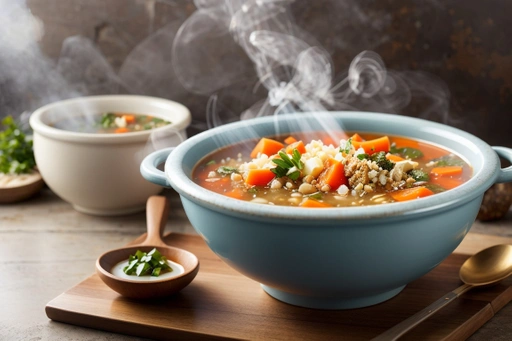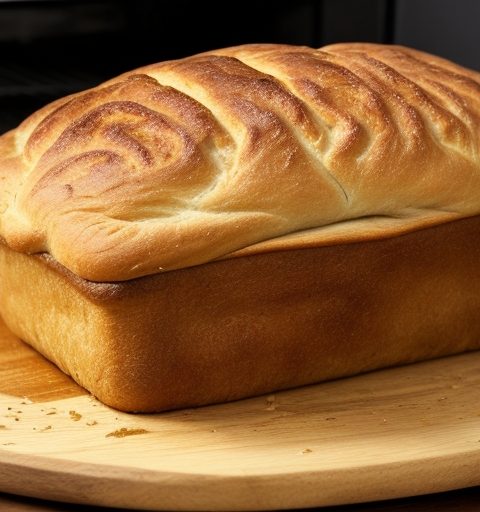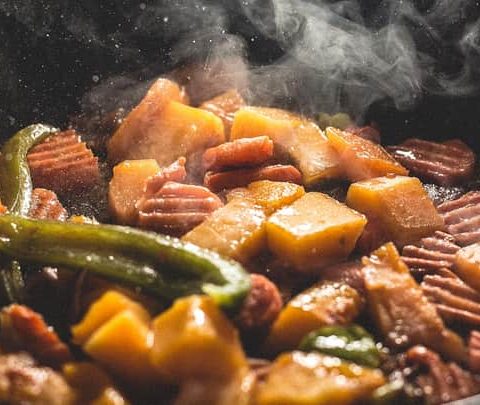As an experienced food blogger with over 10 years of experience, I often get asked how to properly freeze and reheat soup without compromising its texture or flavor. Soups are a great make-ahead meal, but the process of freezing and reheating them can be tricky.
With this comprehensive guide, I’ll walk you through my proven tips for freezing and reheating soup like a pro.
- Related: Best Herbs For Vegetable Soup
Selecting the Right Soup to Freeze
Not all soups freeze and reheat equally well.
Here are some tips for choosing soups that hold up best:
Hearty Soups with Thick Textures
Chunky soups with hard vegetables or beans freeze best. The chunks of vegetables and protein maintain their texture better. Try freezing broccoli cheese, potato, lentil, or minestrone soup.
Avoid Thin Broths and Dairy-Based Soups
Thin broths and soups made with lots of dairy tend to separate or curdle when frozen. Stay away from freezing egg drop soup, chicken noodles, or cream soups.
Cool Completely Before Freezing
It’s important to let your soup cool down completely before freezing. Freezing piping hot soup will cause ice crystals to form and affect texture. Let it cool to room temperature first.
Try these Amazing Coriander Soup
How to Package Soup for the Freezer
Choosing the right storage containers is key for frozen soups. Here are some of my top tips:
Use Freezer-Safe Containers
Glass and plastic freezer containers are best for storing soup long-term. Make sure to leave 1-2 inches of headspace to allow for expansion.
Portion into Individual Servings
Freeze soup in portion-sized containers. This prevents you from having to thaw out a huge batch at once. Mason jars or silicone freezer molds work great.
Use Freezer Bags for Bulk Storage
For larger amounts, you can use heavy-duty freezer bags. Lay the bags flat in your freezer to prevent spillage and freezer burn.
Label with Date and Contents
Always label your frozen soup with the date, name of the soup, and any other important info. This helps identify and rotate frozen items.
Tips for Freezing Soup
Follow these steps when freezing soup for the best quality:
Let Sit Overnight in the Fridge
After packaging the soup, refrigerate it overnight before freezing. This helps chill it thoroughly and prevents large ice crystals.
Freeze Individual Portions on a Baking Sheet
If freezing smaller containers, arrange them on a baking sheet in a single layer and freeze. Once solid, you can stack them together in a bag.
Freeze Quickly at 0°F or Below
For best results, freeze soup as fast as possible at 0°F or below. Quick freezing prevents damaging ice crystals from forming.
Leave Space for Expansion
Make sure to leave headspace in containers as liquids will expand as they freeze. About 1-2 inches of space is ideal.
Store Soup for up to 3 Months
For best quality and taste, use frozen soup within 3 months. Label bags with the date so you know how long it’s been stored.
Thawing Soup Safely
Thaw your frozen soup properly to avoid food safety risks:
Thaw Overnight in the Fridge
For best results, move frozen soup to the refrigerator to thaw gradually overnight before reheating.
Thaw Sealed Bags in Cold Water
You can also submerge sealed freezer bags in a bowl of cold tap water to thaw. Change the water every 30 minutes until thawed.
Microwave Individual Portions
Microwave single portions on 50% power, stirring every few minutes. Watch carefully to prevent hot spots.
Don’t Thaw at Room Temperature
Never leave frozen soup to thaw on the counter. This allows bacteria to grow in the outer layers before the center thaws.
Cook Thawed Soup Right Away
Once thawed, cook soup immediately. Do not refreeze soup after it has been completely thawed.
Reheating Soup Safely
Follow these reheating methods to restore soup to just-cooked quality:
Simmer on the Stovetop
For best results, reheat thawed soup gently in a saucepan over medium-low heat. Stir regularly until heated through.
Use the Microwave
Microwave individual portions on 50% power, stirring every minute until hot. Watch for boiling or splattering.
Blend Again Before Serving
If the soup is separated or looks curdled, use an immersion blender to re-blend before serving. This restores a smooth texture.
Bring to a Full Boil if Re-Freezing
If you want to freeze leftover soup again, reheat to a full rolling boil for 1 minute before cooling and freezing.
Avoid the Slow Cooker
Don’t use a slow cooker to reheat frozen soup. The prolonged heat can make textures mushy.
Tips for Maintaining Quality
Follow these tips to retain the best texture and flavor in your frozen and reheated soup:
Use Sturdy Vegetables
Choose hardy vegetables like carrots, potatoes, turnips, celery and onions. More delicate veggies get mushy.
Undercook Noodles and Rice
Cook pasta, rice, and grains a minute or two less before freezing. They’ll continue to soften when reheated.
Add Dairy After Reheating
Hold off on adding dairy like cream or milk until after the soup is reheated. This prevents curdling.
Adjust Seasonings
Taste soup after reheating and adjust salt, pepper, and other seasonings as needed. Reheated soup often needs a flavor boost.
Add Fresh Garnishes Before Serving
Brighten up reheated soup with a garnish of fresh herbs, roasted veggies, or a swirl of cream. This improves flavor and texture.
Resources
FAQs:
The safest way to thaw frozen soup is by moving it from the freezer to the refrigerator and letting it thaw gradually overnight before reheating. You can also submerge sealed freezer bags of soup in cold water, changing the water every 30 minutes until thawed. Avoid thawing soup at room temperature.
While it’s not recommended, you can re-freeze thawed soup if you reheat it to a full rolling boil for 1 minute first. This kills off any bacteria that may have grown during thawing. Let it cool completely before freezing again. Do not re-freeze soup without boiling first.
If your reheated soup looks separated or curdled, use an immersion blender to quickly re-blend it before serving. This will smooth out the texture. You can also bring the soup to a gentle simmer while stirring continuously to help reincorporate the ingredients.
Conclusion
Freezing and reheating soup properly is easy when you follow these guidelines. With the right soup choices, packaging, freezing methods, thawing techniques, and reheating tips, you can enjoy delicious homemade soup even when time is short. Proper freezing preserves texture and taste so your soup will reheat to almost freshly-made quality. Use this comprehensive guide to start freezing your favorite soups like a pro.
Try these Amazing Mary Berry Soups Recipe






